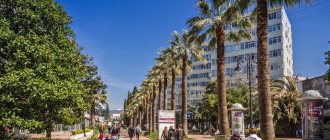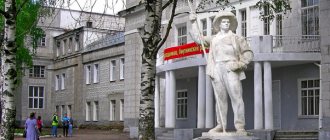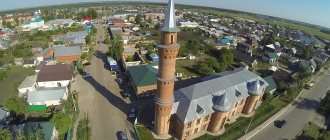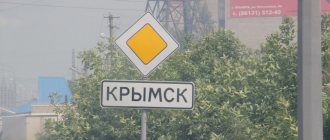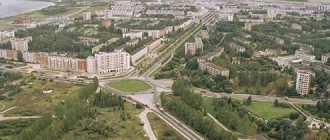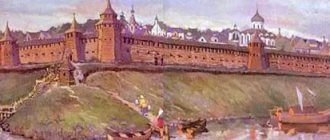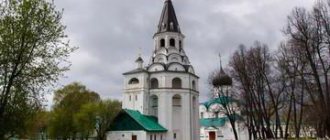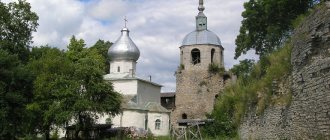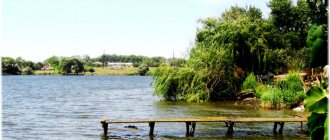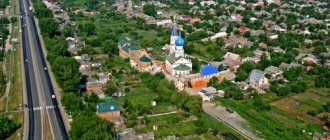Market
The saying “On the left is the market, on the right is the bathhouse - this is Slavyansk-on-Kuban” is widely known outside the Slavyansky region. In the 90s, the city market, which crossed the Protoka River to the Trudobelikovsky farm, attracted a lot of people from the adjacent villages and farms. Now the importance of the market has fallen, the area has shrunk, traders have been eliminated from the streets and sidewalks, trade has become more civilized, but it’s definitely worth seeing how rich the Slavic land is, what beautiful fruits and vegetables it produces, what kind of fish it allows you to catch in the waters of its estuaries.
After the food market, visit the clothing market - “Privoz”. Find out why the Slavs dress the way they do. Prepare to use the phrases “what is the price” and “is this really a leather jacket”?
Church of St. Sarkis
In 2002, the head of the Armenian community turned to the administration of the Slavyansky district with a request to provide a small plot of land for the construction of a temple. Construction lasted about a year.
The church received its name in honor of St. Sarkis. Today it has become not only a religious, but also a cultural center of the region. Within the walls of the church, the local rector conducts Sunday lessons for Armenian children.
Location: Shahumyan street.
Armenian village
This part of the city is famous for the curvature of its streets and its Armenians. While most of the city has a strictly perpendicular layout of streets with rare curvatures, the Armenian village is crooked and braided, since its streets repeat the outlines of the streets of the embryonic village of Slavyanskaya, around which the city then grew. The district is called Armenian because Armenian families liked to settle here, especially during the wave of resettlement from Armenia after the earthquake in Spitak.
- What to see in the city of Krymsk: attractions
Be sure to find the Armenian Apostolic Church among the tricky crossroads of the village. It is very beautiful and geometric, and the attendants will talk to you politely and affably.
Your option in the comments
Surely some particularly significant places were left beyond the author’s attention. But everyone has their own. Tell us: where in Slavyansk-on-Kuban would you take your guests?
ShareClassTweetSharePlus
Sights of Slavyansk-on-Kuban
The city of Slavyansk-on-Kuban is located in the Krasnodar region, in the delta of the Kuban River, 68 km northwest of Krasnodar. The area of the city is 43.5 km/sq., and the population is about 68 thousand people.
Art Gallery
The city's art gallery contains materials on various topics. Here you can find works of contemporary artists. In addition to paintings, the halls contain works by masters of arts and crafts.
For example, the “Russian Matryoshka” exhibition tells how the toy appeared, how it was made by artisans in past centuries, and also shows modern technologies for creating Russian souvenirs.
The art gallery workers are proud of the guests who visited them. The famous Bulgarian singer B. Kirov was amazed by what he saw, he left a laudatory note in the guest book and thanked the workers for the interesting excursion.
Location: Shkolnaya street - 320.
General information
But all these eras were similar in one thing - it was a series of endless wars. In 1607, the Crimean Khan Gazi-Girey, on behalf of Sultan Ahmed 1, built the Kopyl fortress on the right bank of the Kuban. This fortress acquired a bad reputation over time. From there, raids were carried out on all the surrounding settlements and Don villages, on Russian and Persian cities. And in 1737, the Don Cossacks and Kalmyks, with the help of Empress Anna Ioannovna, captured Kopyl and destroyed it. In 1747, the Turks built a new fortress - New Kopyl. It is on the site of this fortress that the stadium of the city of Slavyansk-on-Kuban is now located. Then a city grew around the fortress.
In 1774, a peace treaty was signed with Turkey, and Kuban became independent, and Kopyl was occupied by Russian troops. In 1777, Suvorov became commander of the Kuban corps. He immediately began building fortresses and redoubts around Kopyl. These lands immediately began to become overgrown with settlers, and in 1863 Cossack settlers settled there. In 1792, the right bank Kuban became part of Russia.
In 1865, the Minister of War issued an order to establish 5 new villages in the Kuban region. The Cossack settlement began to be officially called the village of Slavyanskaya. Already in Soviet times, the prefix “na-Kuban” was added, since there was also a city of Slavyansk in the Donetsk region. The village of Slavyanskaya received city status in 1958.
During the Great Patriotic War, the city was under occupation from 1942 to 1943. Today Slavyansk-on-Kuban is a modern and beautiful city, with a developed transport infrastructure (road and rail), industry and agriculture. Food industry enterprises are especially well developed. More than 90% of the city’s residents are Russian, Armenians - 3.5% and Ukrainians -1.5%.
Sights of Slavyansk-on-Kuban
* City museums
Museum of History and Local Lore
- Where is Temryuk? - Krasnodar region
Located on Dzerzhinsky Street. This is the largest museum in Kuban. Was founded in 1976. This museum occupies three buildings, and these buildings belong to architectural monuments of the late 19th and early 20th centuries. The total area of the museum premises occupies 934 square meters. In 1982 the museum received the title of “national museum”.
The number of exhibits in the museum has reached 4.5 thousand units. Visitors can view archaeological and ethnographic collections, rare copies of books and religious objects, bonistics and numismatics. The museum also opened an exhibition of works of art - sculpture, graphics and painting.
The museum pays great attention to the memorial fund of war and labor veterans. 200 sq/m is allocated for the exhibition of flora and fauna of the area. The museum is actively involved in educational activities.
Museum of Nature
Located on Dzerzhinsky Street. Was formed in 1994. Visitors can get acquainted with the nature of the Azov region, environmental protection measures, the environmental situation in the area and the animals listed in the Red Book.
Temples of the city of Slavyansk-on-Kuban
~ Holy Assumption Cathedral
Located on Zaporozhskaya street. The temple was founded in 1907, and construction was completed in 1912. The temple was built according to the design of the Kuban architect A.P. Kosyakina.
In 1920-30, the temple was almost destroyed, but nevertheless it was managed to be defended - it was used as a granary. In 1943, the temple was returned to believers. Bringing the temple back to life required a lot of investment and hard work. The whole world collected money for this good cause. The temple has been completely restored. An additional church was built in honor of St. John of Kronstadt and a parish school. Now the temple is operational and once again pleases the eye with its splendor.
Believers will be interested to know that there are many shrines in the temple:
- Sights of Krasnodar: the most interesting places
~ icon of the Resurrection of the Lord
~ reliquary ark with pieces of the relics of 18 saints
~ Icon of the Dormition of the Blessed Virgin Mary
~ revered image of Jesus Christ, painted during the construction of the temple
~ Church of St. Sarkis
Located on Shahumyan Street. The Armenian community began building this temple in 2002. A year later, construction was completed. Today this church has several thousand parishioners. It runs a Sunday school. In it, children study the history and culture of the Armenian people.
~ St. Panteleimon Church
Located on Shahumyan Street. The old wooden Panteleimon Church stood in Slavyansk-on-Kuban back in 1866, but was destroyed in 1936.
In the 1990s, they began to build a new temple, but in a different place. Construction was completed in 2004. The temple contains the relics of the great martyr and healer Panteleimon and other shrines. The church operates a service of sisters of mercy.
~ Alexander Nevsky Church
This is a newly built magnificent temple complex. It is located on the central agro estate. This is one of the most beautiful places in Slavyansk-on-Kuban. The whole world collected money for the construction of the temple.
Cultural values
* Art Gallery
Located on school street. It was opened in 1995 and is a department of the Slavic Museum of History and Local Lore. The museum has exhibitions of artistic and decorative arts. Along with paintings by recognized masters, exhibitions of local artists are held.
The museum often hosts exhibitions of private collections.
* Park named after the 40th anniversary of the Victory
Located on Shkolnaya street. The park was opened in the center of Slavyansk-on-Kuban on May 8, 1985.
In the park there is the Eternal Flame, an obelisk of the hero of the Soviet Union N.D. Curls, busts of all the heroes of the Soviet Union who were born in Slavyansk, as well as plates with the names of all the soldiers of the Slavyansk region who died during the war. Now the park is being replenished with new slabs with the names of soldiers who died in local conflicts.
* Park "Alley of Brides"
Located on Shkolnaya Street. The name of the park speaks for itself - newlyweds come here on their wedding day. It is popular among those who like to conduct photo shoots. The park is well-equipped, it has walking and cycling paths, and a lot of green spaces.
* Monument to the Taman Red Army
Located on Naberezhnaya street. It is one of the main symbols of Slavyansk-on-Kuban, therefore it is depicted on the city’s coat of arms.
The monument is very beautiful and solemn. It is a high stele with memorial plaques on a special platform, around which 8 artillery pieces are installed. At the top of the stele there is a star with a wreath, and below there is a defeated snake, as a sign of counter-revolution.
The monument is dedicated to the heroic 500-kilometer march of Kuban soldiers through the main Caucasian ridge during the civil war.
* Monument to V. F. Margelov
Installed on Zaporizhskaya Street in 2015. The monument is a bust of the hero of the Soviet Union Vasily Filippovich Margelov, the founder of the airborne troops. The bust was installed on the initiative of Airborne Forces veterans.
–>
| RSSDiscuss |
Pages: 1B 2B
// ts58.livejournal.com The whole essence of this city is in its name. And not in its first part, which relates it to its notorious Donetsk namesake, but in the second. And “Kuban” in this case is not the name of the river - formally it does not flow through Slavyansk at all. Kuban here is precisely the region of which this city is the quintessence. Here, on a relatively small piece of land, there is everything that can serve as some distinctive characteristic of the flat Krasnodar region. And endless streets with a modern private sector, and old southern one-story buildings, and incredible landscaping for a provincial Russian town, and strong agriculture, and production sites of international corporations, and Kuban prosperity. In addition, the largest agricultural complex in Europe is located here, whose fruit orchards stretch over thousands of hectares in the suburbs of Slavyansk. There are very few travel notes about this city on the Internet (if not to say that there are none at all), which is somewhat unfair. Slavyansk-on-Kuban, among other things, also has a rather nice southern pre-revolutionary center and a couple of iconic historical attractions. In general, I invite you to take a walk around the southern city, which is greatly underestimated by tourists. The center of Slavyansk-on-Kuban is the pedestrian street Krasnaya, starting from the amusement park on the banks of the Protoka River. In the blocks adjacent to the pedestrian street and the river there are most of the most interesting old houses in Slavyansk. And the street begins with a huge memorial complex. Monuments of both the Great Patriotic War and the Afghan and Chechen wars are collected here. Several monuments are concentrated in one place. The size of the complex is impressive - if you post photographs of all its elements, you will have to write another post about Slavyansk. // ts58.livejournal.comBehind the memorial is the children's art school named after. Ponomarenko. Obviously some old building, but I couldn’t find any information about it: // ts58.livejournal.com Red Street, with the exception of a small central section, is not paved with tiles or cobblestones, as we are used to on pedestrians. It's just an ordinary street with no traffic. Individual official vehicles can drive through it. However, the main administrative and recreational institutions of the city are located here, including a cultural center, a hotel, cafes and restaurants. The tax office building is also very interesting: // ts58.livejournal.com Like all populated areas of the Krasnodar Territory, Slavyansk-on-Kuban looks much more crowded and bustling than similar-sized cities in the center or north of Russia. Apparently, the nominal number here is close to the actual one, and in official statistics there are no thousands of “dead souls” who have been living in Moscow or St. Petersburg for a long time. Honor board in a fashionable modern design: // ts58.livejournal.com In those days when we were there, the Kerch crossing was undergoing reconstruction, which is why its capacity was noticeably lower. A huge number of trucks wanting to get to Crimea were forced to stand in queues. Their distribution point was Slavyansk-on-Kuban, located more than a hundred kilometers from the port of Kavkaz. The entire bypass of Slavyansk and its suburbs were covered with trucks. The spectacle is amazing, even though they didn’t dare to film it. In the center of Slavyansk, however, there was nothing to remind us of this. House of Culture 1958. It seems that at that time similar buildings were built according to standard designs, but I don’t remember anything similar to this recreation center: // ts58.livejournal.com The population of Slavyansk is more than 65 thousand people - comparable, for example, to Dmitrov near Moscow. But, as in all Kuban cities, the basis of the housing stock here is the private sector, although high-rise buildings are also present to a large extent. Consequently, the area of the city turns out to be very large; it takes about twenty minutes to get from end to end. And several villages and villages are closely adjacent to the city (including the largest farmstead in the world, Trudobelikovsky), which have actually merged with it. The building occupied by the Azov Sea Nature Museum once belonged to the Temryuk merchant E. G. Grammatikopulo. A branch of the grain export office was located here. // ts58.livejournal.comLike the entire Krasnodar region, Slavyansk-on-Kuban is an ancient territory. Both Genoese merchants were noted here in the 12th century (the La Copa trading post, a major center of the slave trade), and the Crimean Tatars (the fortress and city of Kopyl). The center of Slavyansk is rich in such southern pre-revolutionary houses. Today this is where the Slavic regional Cossack society is located: // ts58.livejournal.com But they lived here before the Genoese - back in the 6th-3rd centuries. BC. these territories were part of the Bosporan kingdom. The world's largest treasure of Byzantine gold coins was also found in the Slavyansky region. // ts58.livejournal.comAccording to some sources, the first Cossack settlements began to appear here at the end of the 17th century, during the flight of the Old Believers Cossacks from the Don to the Kuban. Chamber of Commerce and Industry: // ts58.livejournal.com In the 18th century, Kuban became part of Russia. The history of the Russian city here began in 1778, when, during the battles with the Nogais, on the site of the Kopyl fortress, Russian troops built the Slavic Feldshanets - a fortification on the cordon line. Named in honor of the famous Slavic Hussar Regiment, which took part in the battles and subsequently served here. // ts58.livejournal.com Then, in 1778, A. Suvorov, who supervised the arrangement and development of the newly annexed lands, placed his headquarters here. After about two decades, peasants, mainly Black Sea Cossacks, flocked here. // ts58.livejournal.comIn 1865, the settlement was officially given the status of a village and the name “Slavyanskaya”. House of landowner Kryzhanovskaya A.A. - a wealthy landowner who built it for her officer sons. By the way, it was she who owned the lands on which the “Giant Garden” agricultural complex is now located, about which below. Today her mansion is occupied by the police. // ts58.livejournal.comBy 1910, Slavyanskaya was the administrative center of a small territory that included 65 settlements. Some industry was already operating, the first schools, temples, and theaters were being built. The neighboring building also belongs to the police: // ts58.livejournal.com House of the wealthy Slavic merchant Luka Mazepa, 1913. Until recently, it was a children's art school. It is currently in disrepair, but plans are underway to restore it. Along with the monument to the soldiers of the Taman Division (photo 19), it is considered the main attraction of the city. // ts58.livejournal.comIn 1913, the railway came to Slavyansk-on-Kuban. The station is named after the river – “Protoka”. From that moment on, the city became an important point on the routes for transporting grain and bread, which only spurred its development. The station itself looks like a typical southern building, without a sign for some reason. Located on the outskirts. Trains carrying vacationers to Anapa make two-minute stops on it. // ts58.livejournal.com The river station, on the contrary, is not operational and is partially occupied by some offices, although the Channel is navigable along almost its entire length. // ts58.livejournal.com In 1942-1943, the village of Slavyanskaya was under German occupation, during which 3 thousand civilians died. Another 11.5 thousand Slavs did not return from the war. Military assembly building: // ts58.livejournal.com In 1958, the village received the status of a city and its modern name. The building of the Board of the Taman Department of 1915. Now it will be occupied by the Agricultural College: // ts58.livejournal.com The main attraction and symbol of Slavyansk is the monument to the soldiers of the Taman Army on the banks of the Channel. In 1918, the Taman Red Army, cut off from the main forces by the White Guard, marched from Gelendzhik through Tuapse to the village of Dondukovskaya, overcoming fierce resistance. This obelisk, opened in 1923, is one of the first monuments of the Soviet state. I think that’s why it still looks a little old, not Soviet: // ts58.livejournal.com As I wrote at the beginning of the story, the Kuban does not formally flow through the city. Typically, names like “City-on-a-river” imply a water artery. In our case, the postscript was made so as not to be confused with Slavyansk in Donbass. For some reason I didn’t like Slavyansk-on-Protoka. Therefore, the interpretation of Kuban in the name of the city as a region is even more preferable. Although the river can be pulled by the ears, because Protoka is nothing more than a branch in the Kuban delta: // ts58.livejournal.com
Pages: 1B 2B
–>
| RSSDiscuss |
One of the main sectors of the economy of the Krasnodar region is tourism. There are many cities in the region where anyone can spend an unforgettable vacation. Tourists will also like Slavyansk-on-Kuban. The sights of this settlement surprise visitors with their beauty and diversity.
Museum of Nature of the Eastern Azov Region
Until 1986, all materials and exhibits about the nature of the Azov region were in the local history museum. It was this year that the foundation of the Museum of Nature of the Eastern Azov Region was laid. The opening took place in 1994. The main theme of all presented expositions was “the nature of the native land.”
Here you can see collections of insects and rare birds that are listed in the Red Book. Dioramas dedicated to the nature of the Azov region were created in the halls. There is a collection telling about rare sea inhabitants; bird eggs from all over the world have been collected.
Excursions are conducted according to age categories. Games and quizzes are held for children and teenagers, while material is presented to adults in the form of lectures. Museum staff continue to study unknown representatives of flora and fauna, and replenish the funds with new exhibits.
Location: Dzerzhinsky street - 261.
Information about the city
Slavyansk-on-Kuban is a small settlement in the south of the Russian Federation, part of the Krasnodar Territory and the administrative center of the Slavyansk region. A short distance from the regional capital (only 68 km) makes the city one of the most popular in the Krasnodar Territory.
The history of the small town began in 1865, when War Minister Milyutin gave the order to found a new settlement. At that time, only a few thousand people lived in the village of Slavyanskaya (one of the old names). Gradually the city grew, which led to the need to build a railway line connecting the village with neighboring cities and regions.
During the war, the entire territory of the Krasnodar Territory was occupied by the Germans. After liberation in 1943, a new stage of history began, which ended only after the collapse of the USSR.
Common data:
- Founding date: 1865;
- city status - since 1958;
- old names - Lo-Kopa, Yeni-Kopyl, Slavyanskaya village;
- area - 43.5 sq. km;
- height above sea level - 8 m;
- number of inhabitants - 66.8 thousand people (according to the 2019 census);
- population density - 1.5 thousand people/sq. km;
- Time zone is UTC+3.
The city is located in a continental climate zone, which is characterized by sharp changes in temperature and humidity. The best time to come on vacation is from mid-June to the end of August. At this time, there is minimal precipitation and the weather is always sunny. The air temperature in the summer months ranges from 20 to 28 degrees. Winter in the region is mild. At this time, a lot of snow falls, which melts at the beginning of spring. The city often experiences strong winds, which contribute to rapid changes in weather conditions.
Due to its proximity to Krasnodar, getting to Slavyansk-on-Kuban is quite easy. The city has a small airport that accepts regional and interregional flights. In addition, tourists can use the railway, which will take them to their destination along the Timashevskaya-Krymskaya line.
Bus services are also well developed. Using this type of transport you can get to the city not only from Krasnodar, but also from most other settlements in the region.
Recreation Park "40 Years of Victory"
The opening of the city recreation park took place on May 8, 1985, and was timed to coincide with the 40th anniversary of Victory Day. By Soviet standards, it was an entire entertainment complex with attractions for children, park alleys, fountains, a summer stage and a theater area. Today, the park still attracts vacationers; at the beginning of 2000, the swings for children were updated to be safer and more modern. Various folk festivals and public events are held in the park.
Location: Krasnaya street.
